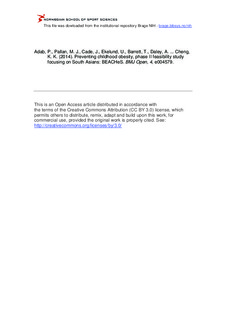| dc.contributor.author | Adab, Peymane | |
| dc.contributor.author | Pallan, Miranda J. | |
| dc.contributor.author | Cade, Janet | |
| dc.contributor.author | Ekelund, Ulf | |
| dc.contributor.author | Barrett, Timothy | |
| dc.contributor.author | Daley, Amanda | |
| dc.contributor.author | Deeks, Jonathan | |
| dc.contributor.author | Duda, Joan L. | |
| dc.contributor.author | Gill, Paramijt | |
| dc.contributor.author | Parry, Jayne | |
| dc.contributor.author | Bhopal, Raj | |
| dc.contributor.author | Cheng, Kar Keung | |
| dc.date.accessioned | 2015-06-01T12:33:22Z | |
| dc.date.available | 2015-06-01T12:33:22Z | |
| dc.date.issued | 2014-04-10 | |
| dc.identifier.citation | BMJ Open. 2014, 4, e004579 | nb_NO |
| dc.identifier.uri | http://hdl.handle.net/11250/284361 | |
| dc.description | This is an Open Access article distributed in accordance with the terms of the Creative Commons Attribution (CC BY 3.0) license, which permits others to distribute, remix, adapt and build upon this work, for commercial use, provided the original work is properly cited. See: http://creativecommons.org/licenses/by/3.0/ | nb_NO |
| dc.description.abstract | Objective: To assess feasibility and acceptability of a multifaceted, culturally appropriate intervention for preventing obesity in South Asian children, and to obtain data to inform sample size for a definitive trial.
Design: Phase II feasibility study of a complex intervention.
Setting: 8 primary schools in inner city Birmingham, UK, within populations that are predominantly South Asian.
Participants: 1090 children aged 6–8 years took part in the intervention. 571 (85.9% from South Asian background) underwent baseline measures. 85.5% (n=488) were followed up 2 years later.
Interventions: The 1-year intervention consisted of school-based and family-based activities, targeting dietary and physical activity behaviours. The intervention was modified and refined throughout the period of delivery.
Main outcome measures: Acceptability and feasibility of the intervention and of measurements required to assess outcomes in a definitive trial. The difference in body mass index (BMI) z-score between arms was used to inform sample size calculations for a definitive trial.
Results: Some intervention components (increasing school physical activity opportunities, family cooking skills workshops, signposting of local leisure facilities and attending day event at a football club) were feasible and acceptable. Other components were acceptable, but not feasible. Promoting walking groups was neither acceptable nor feasible. At follow-up, children in the intervention compared with the control group were less likely to be obese (OR 0.41; 0.19 to 0.89), and had lower adjusted BMI z-score (−0.15 kg/m2; 95% CI −0.27 to −0.03).
Conclusions: The feasibility study informed components for an intervention programme. The favourable direction of outcome for weight status in the intervention group supports the need for a definitive trial. A cluster randomised controlled trial is now underway to assess the clinical and cost-effectiveness of the intervention. | nb_NO |
| dc.language.iso | eng | nb_NO |
| dc.publisher | BMJ Publishing | nb_NO |
| dc.title | Preventing childhood obesity, phase II feasibility study focusing on South Asians: BEACHeS | nb_NO |
| dc.type | Journal article | nb_NO |
| dc.type | Peer reviewed | nb_NO |
| dc.subject.nsi | VDP::Medical disciplines: 700 | nb_NO |
| dc.source.journal | BMJ Open | nb_NO |
| dc.description.localcode | Seksjon for idretssmedisinske fag / Department of Sports Medicine | nb_NO |
